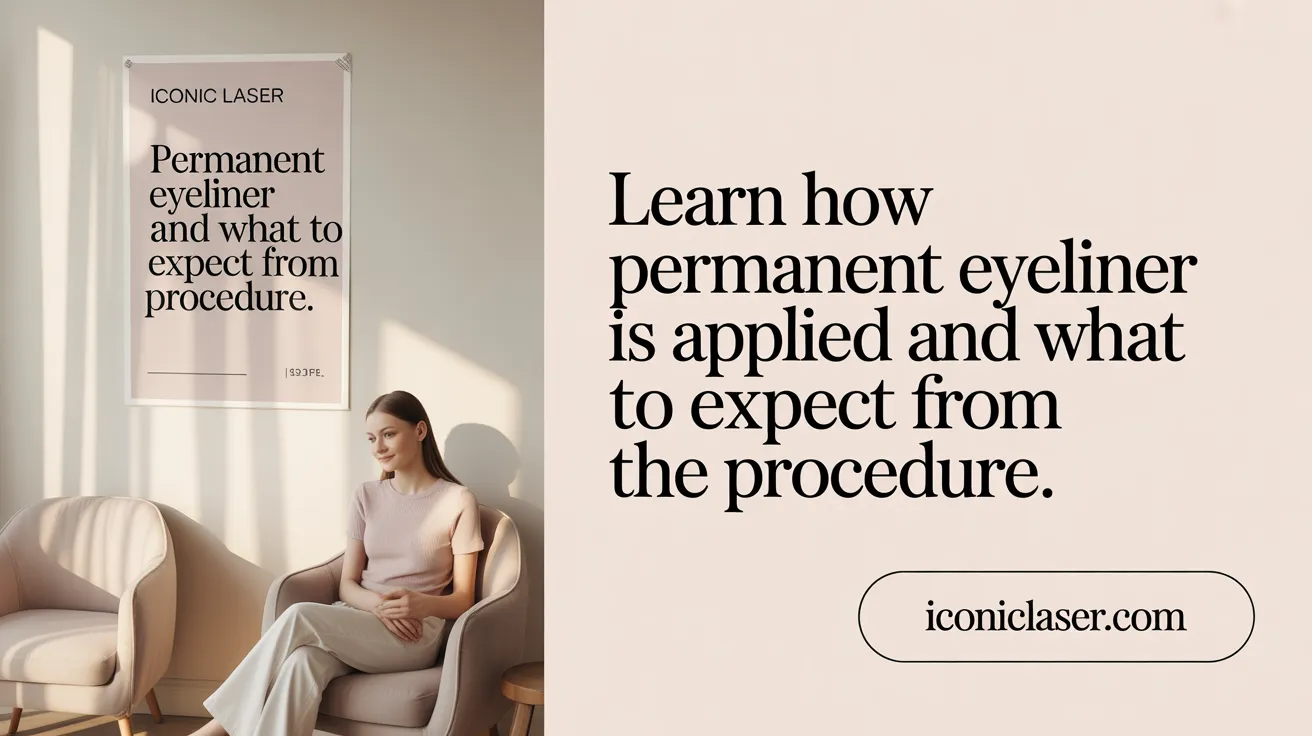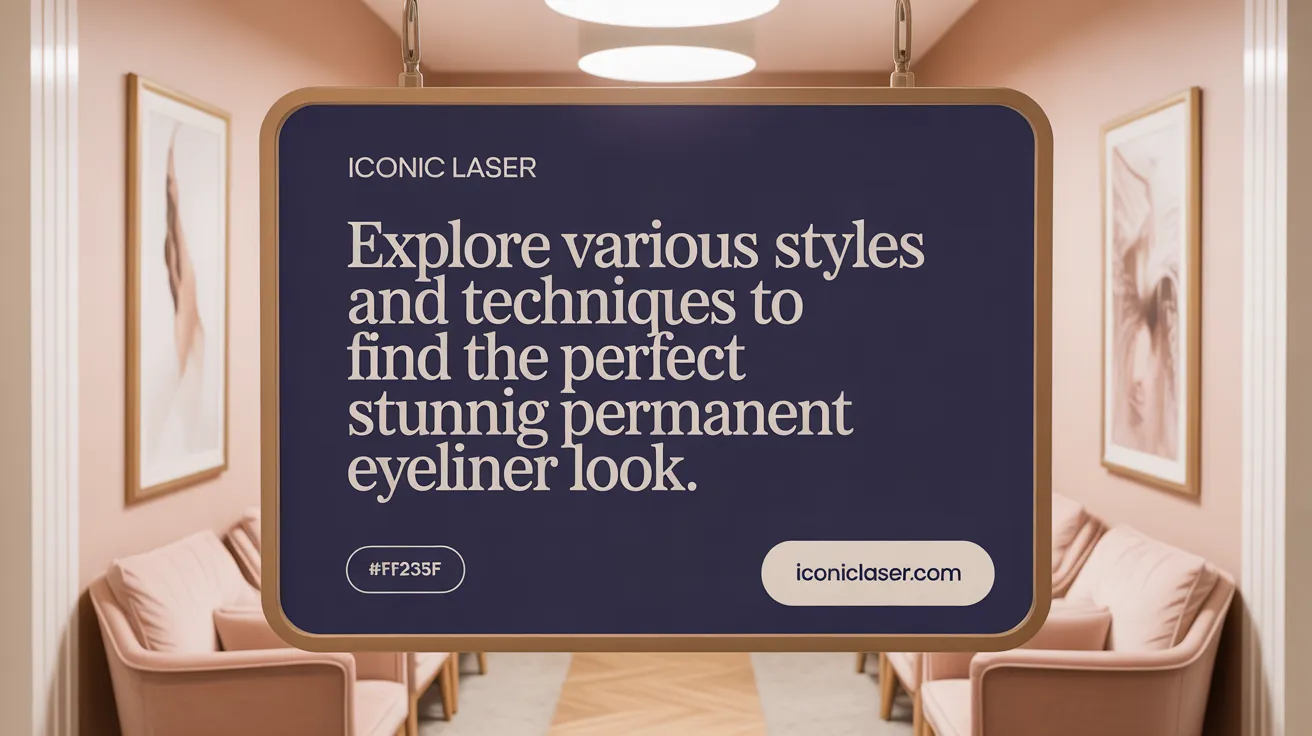Discover the Beauty and Practicality of Permanent Eyeliner
Permanent eyeliner has become a popular cosmetic procedure for those seeking a hassle-free, long-lasting eye enhancement. This article delves into the procedure, its benefits and risks, various styles, and essential aftercare tips to help you make an informed decision about whether this semi-permanent makeup solution is right for you.
Understanding Permanent Eyeliner: What It Is and How It Works

What is permanent eyeliner and how does it work?
Permanent eyeliner is a cosmetic tattooing procedure that deposits pigment along the lash line to create the appearance of eyeliner, offering a semi-permanent makeup solution. The process involves numbing, designing the desired look, and using a tattoo machine or pen-like instrument to implant pigment into the upper layer of skin, lasting approximately one to three years.
Although called "permanent," the pigment gradually fades over time due to the body breaking down and absorbing the ink, necessitating touch-up sessions to maintain the look. The pigments used are larger particles than traditional tattoo ink, making the results semi-permanent.
This procedure benefits individuals seeking to eliminate daily eyeliner application, those with allergies to traditional makeup, or people with physical limitations affecting their ability to apply makeup. It can also enhance the natural eye shape, giving a more defined or fuller appearance.
During the procedure, a technician applies a numbing agent to minimize discomfort and then carefully implants pigment along the lash line using a specialized tattoo device. The process usually takes about one hour for a simple line, with more complex styles taking longer.
While generally safe when performed by experienced professionals, risks include infection, allergic reactions, eye injury, and potential scarring. Ensuring the work is done with sterilized equipment and reputable practitioners is essential for safety.
The results are long-lasting but not permanent, as pigment fades due to skin cell turnover and body absorption, often requiring touch-ups every 1 to 3 years to keep the desired intensity.
Exploring Benefits and Drawbacks of Permanent Eyeliner

What are the advantages and disadvantages of permanent eyeliner?
Permanent eyeliner offers several benefits that make it a popular choice for many. One of the main advantages is the significant time saved in daily makeup routines. Since the pigment is implanted along the lash line, individuals no longer need to spend time applying eyeliner each morning. This can be especially helpful for those who have busy schedules, limited eyesight, shaky hands, or physical conditions that make precise makeup application difficult.
Additionally, permanent eyeliner provides a consistent look that doesn't smudge, fade, or wash away with water or sweat. It enhances natural eye definition, making lashes appear thicker and eyes brighter even without additional makeup. It is also an excellent option for people with allergies to traditional cosmetics or sensitive skin, reducing the risk of allergic reactions.
However, there are some notable drawbacks. The procedure involves minor discomfort, swelling, or tenderness during healing, and there are risks of infection, allergic reactions, or eye injury if not performed by a qualified professional. Removing or altering the pigment later can be difficult, painful, and often incomplete, as the ink is permanent but gradually fades over time. The effects typically last around one to three years, after which touch-ups are needed to maintain the appearance.
Moreover, once the pigment fades or if a person’s style changes, they might find it challenging or costly to remove or modify the tattoo. Changes in skin aging or shifting fashion trends can affect satisfaction with the results over time. Despite its long-lasting nature, permanent eyeliner is not entirely permanent; it requires ongoing maintenance and realistic expectations.
Permanent Eyeliner Styles and Application Techniques

What procedures and techniques are involved in applying permanent eyeliner, and what styles are available?
Permanent eyeliner is achieved through a tattooing process that deposits pigment along the lash line, creating a long-lasting or semi-permanent eyeliner look. The procedure begins with a consultation where the desired style and shape are discussed. The technician then applies a numbing agent to minimize discomfort.
The actual application involves using a specialized tattoo machine or pen that gently implants pigment into the skin along the lash line. This process typically takes between 1 to 2 hours, depending on the complexity of the design.
Various styles are available to suit individual preferences and facial features. These include:
| Style Name | Description | Effect | Suitable For |
|---|---|---|---|
| Invisible Liner (Lash Enhancement) | Slight darkening along the lash line | Natural, subtle enhancement | People wanting a barely-there look |
| Classic Eyeliner | Defined line along the lash line | More noticeable, mimics regular eyeliner | Those seeking a balanced look |
| Smudged or Smoky Eyeliner | Blended, softer edges | Creates a sultry, smoky effect | Fans of a softer, more dramatic style |
| Winged or Cat Eye | Extended flicks at outer corners | Dramatic, elongated eye appearance | Those wanting a bold, fashionable look |
| Bold and Thick Line | Heavy, prominent line | Maximal definition | Preference for striking eye makeup |
Customization options include thickness, color, and the angle of the winged tips. These choices allow clients to tailor their permanent eyeliner to complement their eye shape and personal style.
How does the procedure work?
The process involves several key steps:
- Consultation and Design: The technician discusses and plans the desired style.
- Preparation: Application of a topical anesthetic to reduce discomfort.
- Pigment Implantation: Using a tattoo machine, pigment is carefully inserted along the lash line.
- Healing and Aftercare: The area may be tender, with initial redness and swelling. Proper aftercare includes keeping the area clean, avoiding makeup, and protecting from sun exposure.
The result is a long-lasting eyeliner that can vary in intensity and style. Regular touch-ups may be necessary every 1 to 3 years to maintain vibrancy, as the pigment gradually fades over time due to skin renewal and environmental factors.
Choosing an experienced, credentialed professional ensures safe application and natural-looking results, with minimal risks of infection, allergic reactions, or uneven fading.
Safety First: Essential Precautions and Risks with Permanent Eyeliner
 Getting permanent eyeliner can offer lasting beauty benefits, but it’s crucial to understand the safety precautions involved. Ensuring that the procedure is performed by a licensed and experienced practitioner is the first step. Reputable professionals follow strict sterilization protocols, use approved equipment, and select high-quality pigments, significantly reducing the risk of infection and complications.
Getting permanent eyeliner can offer lasting beauty benefits, but it’s crucial to understand the safety precautions involved. Ensuring that the procedure is performed by a licensed and experienced practitioner is the first step. Reputable professionals follow strict sterilization protocols, use approved equipment, and select high-quality pigments, significantly reducing the risk of infection and complications.
Before proceeding, clients should have an open discussion about their medical history, allergies, and sensitivities. Patch testing is recommended to identify any allergic reactions to specific inks or dyes used during the procedure, as some organic or synthetic pigments may cause reactions in sensitive individuals.
Despite the generally safe nature of the procedure, potential risks include allergic responses, granulomas, keloids, and scarring. People with sensitive skin, prone to scars, or with pre-existing skin conditions should consult healthcare providers before undergoing treatment.
Infection is a primary concern if sterilization is inadequate or aftercare instructions are ignored. Following proper aftercare—such as keeping the area clean, avoiding water and makeup for a designated period, and protecting from sun exposure—is essential. Clients should be vigilant for signs of infection, including redness, swelling, or discharge.
Certain health conditions can affect healing or increase risks, such as diabetes or autoimmune diseases. Pregnant or nursing women are advised to consult with healthcare providers before getting permanent makeup.
To maximize safety and achieve natural-looking results, thorough research on qualified, reputable practitioners and adherence to pre- and post-procedure guidelines are vital. Proper precautions help prevent complications and ensure a positive experience.
Step-by-Step Guide to Aftercare and Healing for Permanent Eyeliner

What are the recommended aftercare instructions and healing process for permanent eyeliner?
The healing journey after getting permanent eyeliner usually spans about 4 to 6 weeks. During this time, the eyelid area experiences several stages, including swelling, redness, scabbing, peeling, and pigment settling. Right after the procedure, it is crucial to avoid touching, scratching, or applying any makeup on the treated area to prevent infections or pigment disruption.
Initially, expect some swelling and a darker appearance of the eyeliner. Mild discomfort is common and can be managed with prescribed or recommended ointments. The first few days often involve scabbing and crusting; it’s essential not to pick at these scabs as they are part of the natural healing process.
Healing methods can be dry or wet. Dry healing involves allowing the area to breathe and avoiding excessive moisture, reducing the risk of infection but possibly causing more scabbing. Wet healing, meanwhile, encourages keeping the area slightly moist with ointments or healing gels, which can minimize scabbing and improve color retention but requires careful maintenance.
Proper cleaning techniques include gentle cleaning with a mild, fragrance-free cleanser if necessary, and applying the recommended ointments—such as petroleum jelly or healing creams—according to your technician's instructions. Keeping the area clean and protected from irritants is vital.
Protecting the eyelids from sun exposure is paramount. UV rays can fade pigment or cause hyperpigmentation. It is advised to wear sunglasses and avoid direct sunlight during the healing period.
Water contact should be minimized. Refraining from swimming, hot tubs, and exposure to excessive moisture helps prevent complications during recovery.
As healing progresses, the pigment may lighten temporarily due to natural skin exfoliation. The final, settled color generally stabilizes around six weeks and can be refined with a follow-up touch-up appointment.
In summary, consistent aftercare—such as gentle cleansing, moisture application, sun protection, and avoiding irritants—is essential for optimal results. Adhering to these guidelines ensures the pigment heals well and retains its intended shape and color.
For lasting beauty, a touch-up session is recommended around six weeks after the initial procedure, which helps perfect the look and address any fading or uneven areas. Being patient and diligent throughout this process results in a beautiful, long-lasting eyeliner that saves time on daily makeup routines.
Comparing Permanent Eyeliner with Traditional Makeup and Other Cosmetic Tattoos
Permanent eyeliner is a semi-permanent cosmetic procedure that involves implanting pigment into the skin around the eyes using a tattoo machine. This process creates a long-lasting enhancement of the eye area, typically lasting between 1 to 3 years, depending on individual factors like skin type and lifestyle. Unlike daily makeup application, which requires applying eyeliner each morning and removing it at night, permanent eyeliner offers the convenience of constant defined eyes without ongoing effort.
In contrast to traditional makeup, permanent eyeliner is more durable and resistant to smudging, water, and fading from exposure. It provides a consistent, polished look that can be customized into styles such as classic, winged, or shadow liner, but requires careful application by experienced professionals to ensure natural results and safety.
When compared to other permanent makeup procedures, like microblading for eyebrows or lip tinting, eyeliner tattooing is less invasive but demands high precision due to the sensitivity of the eye area. While microblading involves creating hair-like strokes in the brows, eyeliner focuses on precise pigment placement along or within the lash line. Both techniques involve some discomfort and healing time, but eyeliner tends to be quicker and generally less traumatic.
However, removal of permanent eyeliner is more complicated than removing traditional makeup. Since the pigment is embedded into the skin with a tattooing process, it is not easily wiped away. Removal methods like laser or saline treatments require multiple sessions and can be painful, expensive, and sometimes incomplete.
Maintenance is essential, as the pigment can fade over time due to skin cell turnover and sun exposure. Regular touch-ups are needed every 12-18 months to keep the eyeliner looking vibrant. Despite these considerations, many choose permanent eyeliner for its reliability, time-saving benefits, and suitability for those with allergies or physical limitations that make daily makeup application difficult.
In summary, permanent eyeliner combines the convenience of hassle-free, smudge-proof eye definition with the need for occasional professional touch-ups and careful consideration of removal challenges. It offers a long-lasting alternative to traditional makeup, with the added benefit of customizable styles, making it an appealing choice for those seeking a more permanent beauty enhancement.
Understanding the Costs Behind Permanent Eyeliner
The price of getting permanent eyeliner can vary widely depending on several factors. Typically, the cost ranges from around $475 to over $1,000. This variation depends on the complexity of the style, the experience of the technician, and geographical location.
One of the most significant influences on cost is the skill level of the artist performing the procedure. Reputable, highly experienced professionals usually charge higher rates due to their expertise and the quality of results they deliver. Additionally, the location of the clinic matters: metropolitan areas tend to have higher prices compared to smaller towns or rural settings.
The style and extent of the eyeliner desired can also impact the overall expense. Simple lash line enhancement or thin classic eyeliner might cost less than more elaborate styles like winged or shaded eyeliner. Tourists and those opting for specialized techniques involving multiple colors or layers may also see higher costs.
Beyond the initial procedure, there are ongoing expenses to consider. Touch-up sessions, typically recommended every 12 to 18 months, can cost between $200 and $700. These help maintain the color vibrancy and shape as the pigment naturally fades.
Other expenses include consultation fees, which may sometimes be combined with the procedure, and post-care products such as ointments or sunscreens required during healing. Some clinics may also charge extra if travel to their location is needed.
Choosing a qualified, experienced practitioner is crucial. Proper training and use of sterilized equipment reduce risks such as infection or poor results. Although the upfront cost might be higher, investing in a skilled artist helps ensure a safe process and satisfying long-term results.
For anyone considering permanent eyeliner, understanding all associated costs—initially and ongoing—is essential for making an informed decision. Researching and consulting with professionals can help clarify expectations and budget accordingly.
More info: Searching for "cost of permanent eyeliner tattoo" online can provide detailed pricing options based on your location and chosen style.
Is Permanent Eyeliner Right for You? Assessing Suitability and Expectations
How can one determine if permanent eyeliner is suitable for their personal needs?
Deciding whether permanent eyeliner is a good choice involves evaluating several personal factors. Your skin type plays a role, as oilier skin or skin prone to scarring may influence how long the pigment lasts and how it heals. Medical history is equally important; conditions like allergies, skin sensitivities, or autoimmune disorders can affect your body's response to the pigment or healing process.
Lifestyle considerations are crucial. If you enjoy swimming, frequent sun exposure, or have an active lifestyle, permanent eyeliner might help maintain a look without daily effort. However, you should also factor in your ability to commit to proper aftercare, including avoiding water, makeup, and irritants during healing.
Research thoroughly by consulting experienced practitioners who adhere to high hygiene standards and use sterilized equipment. Review their portfolios and client feedback to gauge the quality and natural appearance of their work. Understand that the pigment can fade over 1-3 years and may require touch-ups.
Weigh the benefits—such as saving time, reducing allergy risks, and achieving a consistent look—against potential drawbacks like infection, allergic reactions, and the difficulty of removal. If you have sensitive skin, skin conditions, or are pregnant or nursing, it’s advisable to discuss with healthcare providers.
Ultimately, making an informed decision involves balancing personal preferences, health considerations, and realistic expectations about the longevity and maintenance of permanent eyeliner. Proper research and professional guidance will help you determine if this cosmetic enhancement aligns with your needs and lifestyle.
Practical Tips and Personal Insights for a Successful Permanent Eyeliner Experience
Preparation Steps Before the Procedure
Proper preparation is essential to ensure a smooth and successful permanent eyeliner experience. Patients should avoid lash tinting for two weeks, remove false eyelashes or extensions, and refrain from using lash growth serums for four weeks prior. Additionally, reducing caffeine and alcohol intake before the appointment can help minimize bleeding and sensitivity.
Managing Discomfort and Swelling
Most people experience some discomfort during the procedure, which can be eased with a topical numbing cream. Swelling and tenderness afterward are normal but usually subside within a few days. Using cold compresses and avoiding rubbing the eyes can help manage swelling effectively.
The Importance of Following Aftercare
Adhering to proper aftercare is vital for optimal results. This includes keeping the area clean and dry, avoiding water, makeup, and harsh chemicals for at least one to two weeks. Applying recommended ointments or petroleum jelly helps in healing and reduces dryness. Protecting the area from sun exposure is also crucial to prevent pigment fading.
Choosing Subtle Styles for Lasting Satisfaction
Opt for subtle, natural-looking designs, especially if you're new to permanent makeup. Minimalist styles like lash line enhancement provide a natural boost that ages well and can be augmented with makeup later if desired. Gentle shading or classic eyeliner offers a timeless appearance that doesn’t demand frequent touch-ups.
Insights on Healing Timelines and Touch-Ups
Healing typically takes about one month, during which mild swelling, redness, and scabbing are common. The pigment gradually softens and settles into the skin. Touch-up treatments are often necessary every 12-18 months to maintain vibrancy, especially as the pigment fades over time.
Realistic Expectations and Future Adjustments
While permanent eyeliner provides long-lasting results, it's important to have realistic expectations. The pigment may fade, migrate, or change slightly with age, skin shifts, or sun exposure. Regular touch-ups help keep the appearance fresh and suited to evolving style preferences. Understanding the potential for future adjustments ensures satisfaction and prevents disappointment.
Making an Informed Choice About Permanent Eyeliner
Permanent eyeliner offers a blend of convenience, beauty enhancement, and time savings for many individuals. Understanding the procedure, associated benefits, risks, and diligent aftercare is crucial for achieving optimal results. With preparation, a skilled professional, and proper maintenance, permanent eyeliner can provide years of effortless eye definition. However, it requires thoughtful consideration of personal needs, lifestyle, and potential challenges. A well-informed decision ensures that permanent eyeliner becomes a positive addition to your beauty routine, enhancing confidence and simplifying daily makeup application.
References
- Permanent Eyeliner: Pros And Cons | Daela Cosmetic Tattoo
- The Pros and Cons of Permanent Makeup
- Permanent Eyeliner: Pros, Cons, and Insights on Eyeliner Tattoos
- The Do's and Don'ts of Permanent Eyeliner Aftercare - Nuva Colors
- Permanent Eyeliner: Styles, Benefits, Healing Process & More
- Permanent eyeliner: Pros and cons of cosmetic tattoos
- Semi-Permanent Eyeliner Tattooing: My Experience and Review
- Permanent Eyeliner Pros and Cons - Elix Beauty
- Permanent Makeup Eyeliner: Benefits, Prep, Side Effects and More
